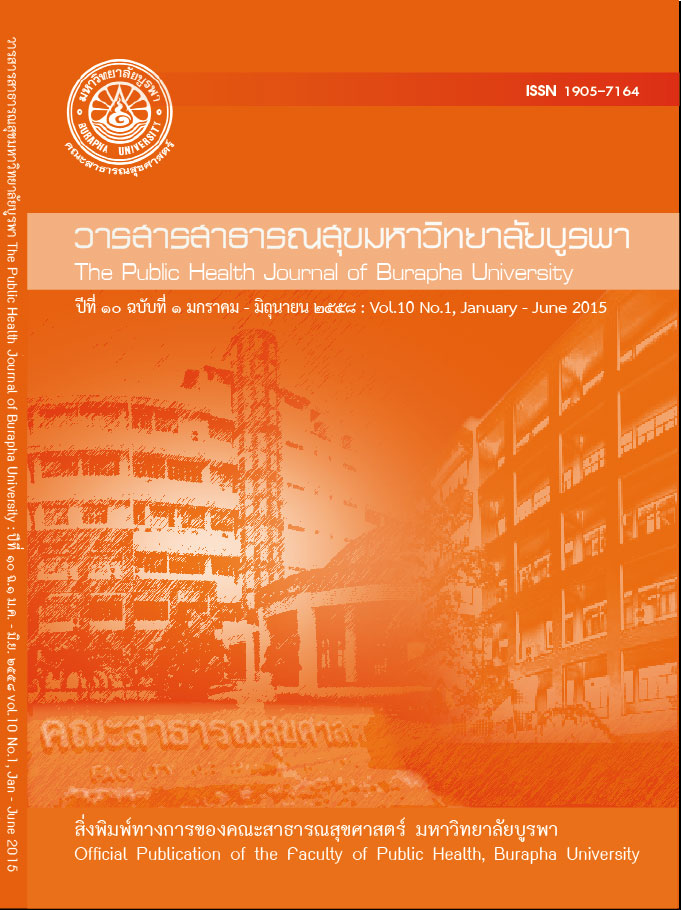Predictors of Play Behaviors of Preschoolers Receiving Service in Child Development Centers
Main Article Content
บทคัดย่อ
ปัจจัยทำนายพฤติกรรมการเล่นของเด็กวัยก่อนเรียนที่เข้ารับบริการ ในศูนย์พัฒนาเด็กเล็ก
สาวิตรี วงศ์อินจันทร์*, ยุนี พงศ์จตุรวิทย์**, นุจรี ไชยมงคล**
*พยาบาลศาสตรมหาบัณฑิต สาขาการพยาบาลเด็ก คณะพยาบาลศาสตร์ มหาวิทยาลัยบูรพา
**คณะพยาบาลศาสตร์ มหาวิทยาลัยบูรพา
การวิจัยแบบหาความสัมพันธ์เชิงทำนายครั้งนี้มีวัตถุประสงค์เพื่อศึกษาปัจจัยทำนายพฤติกรรม การเล่นของเด็กวัยก่อนเรียนที่เข้ารับบริการในศูนย์พัฒนาเด็กเล็ก ในความรับผิดชอบของเทศบาล เมือง จังหวัดชลบุรีกลุ่มตัวอย่างเป็นบิดาหรือมารดาและเด็กวัยก่อนเรียน จำนวน 84 ราย คัดเลือก โดยการสุ่มแบบหลายขั้นตอน เก็บรวบรวมข้อมูลระหว่างเดือนกันยายน – ตุลาคม พ.ศ. 2556 เครื่องมือที่ใช้ในการเก็บรวบรวมข้อมูล ประกอบด้วยแบบสอบถาม 5 ชุด ได้แก่ 1) แบบสอบถาม ข้อมูลทั่วไป 2) แบบสอบถามพื้นอารมณ์ของเด็กวัยก่อนเรียน 3) แบบสอบถามความสัมพันธ์ ในครอบครัว 4) แบบสอบถามสภาพแวดล้อมที่บ้านของเด็กวัยก่อนเรียน และ 5) แบบสอบถาม พฤติกรรมการเล่นของเด็กวัยก่อนเรียน ซึ่งประกอบด้วย พฤติกรรมสงวนท่าทีการเล่นคนเดียวที่ไม่มี การเคลื่อนไหว การเล่นคนเดียวที่มีการเคลื่อนไหว การเล่นทางสังคม และการเล่นที่ใช้ความรุนแรง วิเคราะห์ข้อมูลโดยใช้สถิติพรรณนา สหสัมพันธ์ของเพียร์สัน และสถิติถดถอยพหุคูณแบบขั้นตอน ผลการวิจัยพบว่า พฤติกรรมการเล่นทางสังคมมีคะแนนเฉลี่ยรายข้อมากที่สุด โดยพื้นอารมณ์ ของเด็ก ความสัมพันธ์ในครอบครัว และสภาพแวดล้อมที่บ้าน มีความสัมพันธ์กับพฤติกรรมการเล่น ทางสังคมของเด็กวัยก่อนเรียน (r = .589, p < .01; r = .563, p < .01 และ r = .599, p < .01 ตามลำดับ) สภาพแวดล้อมที่บ้านเป็นตัวทำนายที่ดีที่สุดและมีนัยสำคัญทางสถิติสามารถทำนาย พฤติกรรมการเล่นทางสังคมของเด็กวัยก่อนเรียนได้ร้อยละ 35.9 (B = .771, t = 3.818,p < .001) และพื้นอารมณ์ของเด็กเป็นตัวทำนายที่ดีเป็นลำดับที่ 2 ทำนายได้เพิ่มขึ้นร้อยละ 8.8 (B = .113, t = 3.580, p < .01) และตัวแปรทั้งสองสามารถร่วมกันทำนายพฤติกรรมการเล่นทางสังคมของเด็ก วัยก่อนเรียนได้ร้อยละ 44.6 (F(2,81) = 32.641, p < .001)
ผลการศึกษาแสดงให้เห็นว่าสภาพแวดล้อมที่บ้าน และพื้นอารมณ์ของเด็ก มีความสำคัญและ ส่งผลต่อพฤติกรรมการเล่นทางสังคมของเด็กวัยก่อนเรียน ดังนั้นผู้ที่เกี่ยวข้องกับการดูแลเด็กวัย ก่อนเรียนควรจัดสภาพแวดล้อมที่บ้านให้เหมาะสมกับเด็ก และให้ความสำคัญกับพื้นอารมณ์ของเด็ก เพื่อให้เด็กวัยก่อนเรียนมีพฤติกรรมการเล่นที่เหมาะสม
This predictive correlational study was conducted to examine the predictors of the play behaviors of preschoolers receiving service in child development centers in the municipality of Chon Buri province. The sample included 84 fathers or mothers, and the preschoolers. Multistage random sampling was used to recruit the sample. The data was collected during September and October, 2013. The research instruments consisted of: 1) the demographic questionnaire; 2) the preschool temperament questionnaire; 3) the family relation questionnaire; 4) a home environment questionnaire, and; 5) the preschool play behavior scale, including: reticent behavior, solitary-passive behavior, solitary-active behavior, social play and rough-play. The data was analyzed by using descriptive statistics, Pearson’s correlation, and stepwise multiple regression.
Results revealed that social play had the highest average score. Child temperament, family relationships, and home environments were associated with the preschoolers’ social play behaviors (r = .589, r = .563, and r = .599, p < .01, respectively). Home environment was the best predictor accounting for 35.9% (B = .771, t = 3.818, p < .001) in the prediction of play behaviors; the second best predictor was child temperament accounting for 8.8% (B = .113, t = 3.580, p < .01). Together, these two variables were able to predict and account for 44.6% (F(2,81) = 32.641, p < .001).
The findings suggested that home environment and child temperament were the significant factors and had an influence on the social play behavior among the preschoolers. Therefore, those involved with the care of the children should provide an appropriate home environment for the child and should focus on the temperament of the child in order to promote appropriate play behaviors among the preschoolers.

